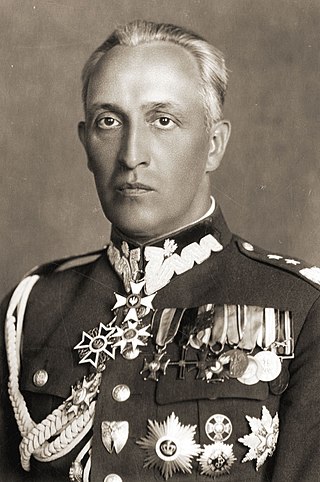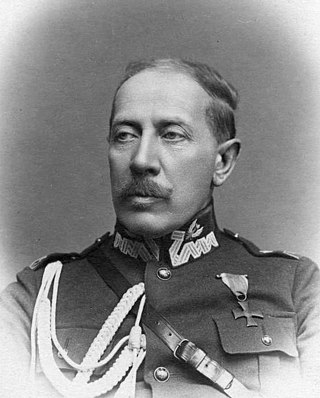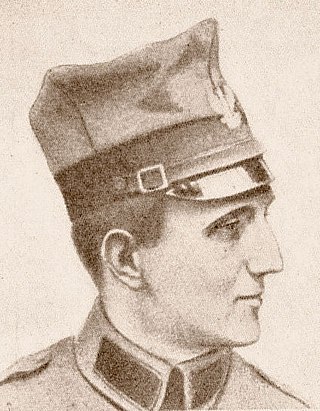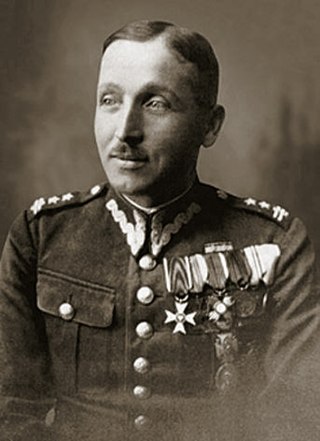
Gustaw Konstanty Orlicz-Dreszer was a Polish general, and a political and social activist.

Jerzy Włodzimierz Świrski was a Polish vice admiral and officer in the Russian Imperial Navy and later the Polish Navy. As Chief of the Polish Naval Command (1925-1947), he was a member of an elite group of high ranking Polish naval officers from foreign navies who became founder members of the re-established naval forces of the newly independent Poland after World War I. During World War II, Polish naval forces under his command, were embedded with the Royal Navy and contributed significantly to the success of Britain's maritime war effort. He notably fell out with Poland's war time Prime Minister-in-exile, General Sikorski, but was backed by the British and survived in post. He was appointed an Honorary Knight Commander of the Order of the Bath.

Stefan Mokrzecki of Ostoja coat of arms (1862–1932) was a general in the Russian Army and the Polish Army. During Polish-Soviet War commanded 8 DP and other units. Later member of armed forces of Republic of Central Lithuania. Retired in 1925. He was brother of Adam Mokrzecki that also was a general in Russian army to end as general of Polish army. He was born in Dzitryki, now in Belarus.

Antoni Wereszczyński was a Colonel in the Polish Army.

Karol Wojtyła was a Polish military officer who was a non-commissioned officer of the Austro-Hungarian Army and a lieutenant of the Polish Armed Forces' administration. He was the father and namesake of Karol Józef Wojtyła, who became Pope John Paul II in 1978, and the father of Polish doctor Edmund Wojtyła. He died from what is believed to be a heart attack in 1941 while his son was away, an event considered to have influenced his son's decision to join the seminary.

Marian Stanisław Chodacki was a Polish diplomat, intelligence officer, certified colonel of the Polish Army, and executive director of the Józef Piłsudski Institute of America.

Janusz Julian Głuchowski was a divisional general of the Polish Army in the Second Polish Republic. Born on August 6, 1888, in Bukowa, he fought in Polish Legions in World War I, Polish–Ukrainian War, Polish–Soviet War and the Invasion of Poland. Głuchowski died on June 11, 1964, in London.

Ludwik de Laveaux was a brigadier general of the Polish Army who served in World War I, World War II and the Polish–Soviet War.

16th Greater Poland Uhlan Regiment of General Gustaw Orlicz-Dreszer was a cavalry unit of the Polish Army in the Second Polish Republic. In the interbellum period, it was garrisoned in the city of Bydgoszcz.

Edmund Wacław Heldut - Tarnasiewicz alias " Heldut ". He was the senior colonel and commander of the Polish Army cavalry, a senior military official of the Polish Armed Forces in the West, who received Poland's highest military award, the Virtuti Militari, one of the oldest military decorations in the world still in use. He was heavily involved in World War I, the Polish–Soviet War, and World War II. Heldut was promoted to General, but the promotion was never confirmed due to the outbreak of World War II. On October 6, 2021, President Andrzej Duda officially and posthumously confirmed Heldut to Brigadier General.

Eugeniusz Świerczewski was a Polish journalist, soldier and drama critic.

Stanisław Dąbek was a Polish infantry colonel in the Polish Armed Forces, he was commander of the Marine Brigade of National Defense and acting commander of the Land Defense of the Coast during the Invasion of Poland; posthumously promoted to the rank of brigadier general.

Arsen Cebrzyński was an aircraft pilot who served in the Polish Air Force, French Air Force and Royal Air Force. In the Polish Air Force and the French Air Force, he had the rank of lieutenant, and in the Royal Air Force, he had the rank of flying officer. He had fought in the World War II, including the Invasion of Poland, Battle of France and the Battle of Britain.

Tadeusz Ludwik Lubicz-Niezabitowski was a Polish colonel who served the Polish Armed Forces and was notable for his participation in the Battle of Grudziądz during the Invasion of Poland.

Stanisław Jan Ferdynand Świtalski was a Polish colonel who was a Certified officer that served in World War I, the Polish–Ukrainian War and in the Invasion of Poland.

Władysław Wiecierzyński was a Polish colonel who was a commander of the Polish Armed Forces and was a knight of the Virtuti Militari.

Jan Franciszek Gaładyk was a Polish Infantry Colonel who was known for being one of the main commanders at the Battle of Węgierska Górka as well as commanding the 1st Mountain Brigade during the Invasion of Poland.

Władysław Kaliński was a Polish Chartered Infantry Colonel who commanded the 13th Infantry Division during World War II and led the Battle of Tomaszów Mazowiecki before being captured after the fall of Warsaw.

Ludwik Czyżewski was a Polish General during the Invasion of Poland during World War II. He commanded the 2nd Legions' Infantry Regiment during the Battle of Borowa Góra but was defeated in the battle. He was also a member of the Border Protection Corps as well as the Home Army before being posthumously promoted to Brigadier General in 1972 by the President-in-Exile, Stanisław Ostrowski.

Władysław Kasza - Podpolkovnik of infantry of the Polish Armed Forces, independence activist, awarded the Virtuti Militari.




















